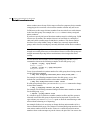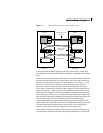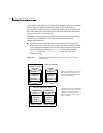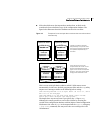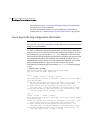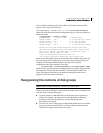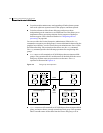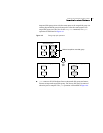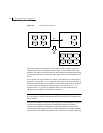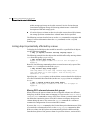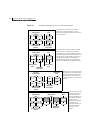
195Creating and administering disk groups
Reorganizing the contents of disk groups
In this example, the disk group has four disks, and is split so that two disks
appear to be on each side of the split.
You can specify the -c option to vxsplitlines to print detailed information
about each of the disk IDs from the configuration copy on a disk specified by its
disk access name:
# vxsplitlines -g newdg -c c2t6d0
DANAME(DMNAME) || Actual SSB || Expected SSB
c2t5d0( c2t5d0 ) || 0.1 || 0.0 ssb ids don’t match
c2t6d0( c2t6d0 ) || 0.1 || 0.1 ssb ids match
c2t7d0( c2t7d0 ) || 0.1 || 0.1 ssb ids match
c2t8d0( c2t8d0 ) || 0.1 || 0.0 ssb ids don’t match
Please note that even though some disks ssb ids might match
that does not necessarily mean that those disks’ config copies
have all the changes. From some other configuration copies,
those disks’ ssb ids might not match.
To see the configuration from this disk, run
/etc/vx/diag.d/vxprivutil dumpconfig /dev/vx/dmp/c2t6d0
Based on your knowledge of how the serial split brain condition came about, you
must choose one disk’s configuration to be used to import the disk group. For
example, the following command imports the disk group using the
configuration copy that is on side 0 of the split:
# /usr/sbin/vxdg -o selectcp=1045852127.32.olancha import newdg
When you have selected a preferred configuration copy, and the disk group has
been imported, VxVM resets the serial IDs to 0 for the imported disks. The
actual and expected serial IDs for any disks in the disk group that are not
imported at this time remain unaltered.
Reorganizing the contents of disk groups
Note: You need a Veritas FlashSnap
TM
license to use this feature.
There are several circumstances under which you might want to reorganize the
contents of your existing disk groups:
■ To group volumes or disks differently as the needs of your organization
change. For example, you might want to split disk groups to match the
boundaries of separate departments, or to join disk groups when
departments are merged.
■ To reduce the size of a disk group’s configuration database in the event that
its private region is nearly full. This is a much simpler solution than the
alternative of trying to grow the private region.




